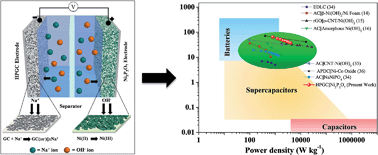Highly porous graphitic carbon and Ni2P2O7 for a high performance aqueous hybrid supercapacitor†
Abstract
An aqueous Na-ion based hybrid capacitor has been successfully developed by using highly porous graphitic carbon (HPGC) derived from waste writing paper and a new electrode material as a negative and positive electrode, respectively. HPGC was prepared via hydrothermal carbonization and subsequent KOH activation of waste writing paper which showed a highly porous stacked sheet-like morphology with an exceptionally high BET specific surface area (1254 m2 g−1). HPGC exhibited typical electrical double layer capacitor (EDLC) behavior with a high specific capacitance of 384 F g−1 and good negative working potential (−1.0 V) in an aqueous electrolyte. On the other hand, Ni2P2O7 was synthesized by a simple co-precipitation technique and tested as a cathode material which delivered a maximum specific capacitance of 1893 F g−1 at 2 A g−1 current density. The fabricated HPGC‖Ni2P2O7 hybrid device displayed excellent cyclic stability up to 2000 cycles and delivered a maximum energy density of 65 W h kg−1 at 800 W kg−1 power density in a Na-ion based aqueous electrolyte.



 Please wait while we load your content...
Please wait while we load your content...